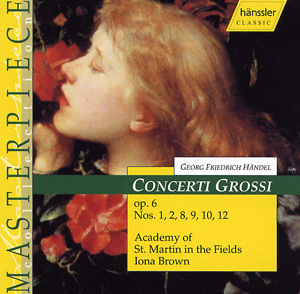|
When someone asked Elgar how he had learned to write
so well for strings, his answer was unequivocal: 'You will find the answer
in Handel; I went to him for help years ago.' And it is true that the
effectiveness and the sheer beauty of the string writing in these Handel
concertos is marvellous. With the concertos of Bach, Handel's Opus 6 set
of twelve concerti grossi represents the high point in baroque orchestral
music.
Handel was the greatest cosmopolitan of the age: a German
composer, living in London, writing Italian operas. Of course he also
wrote a good deal more, such as the oratorios in English which became
his stock-in-trade when the Italian opera went out of fashion. For he
was an immensely practical musician, who made his way by collaborating
with the best artists of the day and working at the highest levels of
performance, creating the music the audience wanted, having already made
a strong impression on the direction of public taste.
The Opus 6 concerti grossi came into being in a manner
at once typical of Handel's career. When the concerti of the Italian ex-patriot
Bononcini became all the rage in London, Handel's publisher, John Walsh
suggested to the great man that he might compose something along similar
lines. He duly obliged, and six weeks later he completed these twelve
concertos.
These twelve concertos are essentially string music,
with keyboard continuo and in some editions the option of oboe parts also,
which are not employed here. Handel's formula is closest to the model
of the concerto da chiesa established by Corelli a generation before,
with the alternation of quicker and slower identities, and with a concertino
group of two violins and cello set against the ensemble. However, in great
music such as this it is dangerous to be too proscriptive in one's descriptions,
since there are so many varieties and shadings.
Iona Brown directs performances full of sensitivity and
insight, and the Hänssler recording allows the string sound the required
bloom and richness. As an example, look no further than the great Larghetto
'slow movement' of Opus 12, which has a keenly judged tempo and a warmly
rich sound (TRACK 30: 0.00). Among other recordings of this music, the
performances of Trevor Pinnock and the English Concert (Archiv), but the
sound quality of the gut strings does not please the ear as the modern
instruments of the Academy do.
Each concerto has abundant subtleties and the highest
levels of inspiration, and all of them are fully worthy of Handel's genius.
The same might be said of these performances, which are beautifully recorded
in a sympathetic acoustic. At bargain price there is no reason to hesitate,
save that bargain price Hänssler discs contain no insert notes, requiring
that the purchaser access the 'free download' of the complete booklet.
This is all very well, but not everyone can do so, and in any case A4
size paper will not fit in a CD-size case.
If the nobility of the slow movements is among the strengths
of Iona Brown's interpretations, the balancing of the part writing and
the lively rhythmic vitality are others. Take the opening measures of
the very first concerto (in G Major) for example, which set the tone for
the whole enterprise (TRACK 1: 0.00). These are ensemble pieces rather
than concertos for solo display, although sometimes the solo group of
two violins and cello can have driving rhythmic passages in the manner
of Vivaldi. These players are experienced hands in this aspect of baroque
repertoire too, and when virtuosity if required they never disappoint.
The penultimate Allegro of Opus 6 No. 10, sounding so like Vivaldi, is
a particularly spirited example (TRACK 26: 0.00).
Terry Barfoot
|
CD Price: £ 11.50 Post-free Air Mail World-wide
- Download Price:
£ 7.11
Buy
CD:
Download all tracks:
FREE SOUND SAMPLES
(minimum 30 secs)
Concerto
Grosso op. 6, No. 1 in G Major:
A
tempo giusto
Allegro
Adagio
Allegro
Allegro
Concerto
Grosso op. 6, No. 2 in F Major:
andante
larghetto
Allegro
Largo
Allegro
ma non troppo
Concerto
Grosso op. 6, No. 8 in C Minor
Allemande:
Andante
Grave
Andante
allegro
Adagio
Siciliana:
Andante
Allegro
Concerto Grosso
op. 6, No. 9 in F Major:
Largo
Allegro
Larghetto
Allegro
Menuet
Gigue
Concerto
Grosso op. 6, No. 10 in D Minor:
Overture
Allegro
lento
Air:
Lento
Air:
Lento
Allegro
Allegro
Concerto
Grosso op. 6, No. 12 in B Minor:
Largo
Allegro
Aria:
Larghetto e piano/Varatio
Largo
Allegro
You
require QuickTime to listed to samples.
Get a free
QuickTime download here
|

